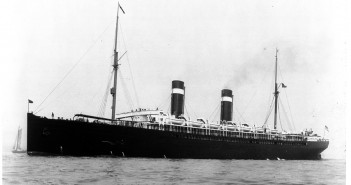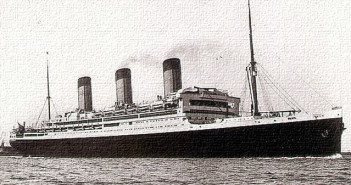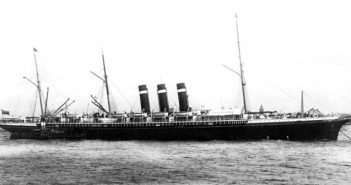Aurania’s three-cylinder compound engines gave her 10 000 horsepower. The high-pressure cylinder measured 68 inches across. The two low-pressure cylinders were larger at 94 inches in diameter. With a piston stroke of six feet, Aurania consumed approximately 215 tons of coal daily.
At 11:47 on the morning of June 23, 1883, Aurania left Liverpool to begin her maiden voyage. She arrived at Queenstown the next afternoon to pick up passengers and mails. In the early morning of June 27, she encountered stormy weather. At that time, her engine room crew noticed loose packing around the low-pressure cylinder. Aurania stopped for six hours to allow for repairs. After breakfast, she continued on her way, thrilling both passengers and crew with average daily runs of nearly 400 miles. At this rate, it appeared as though she might arrive at her New York pier on July 2.
On July 1, her happy passengers stood at the rails to watch for the lights of Fire Island. By suppertime, Aurania met the Mary E. Fish Number 4 pilot boat and John Llewellyn came aboard. Ten minutes later, Aurania was 12 miles east of the Shinnecock Light. Then came a terrible explosion as a broken connecting rod shot upward through the skylightOil and shards of broken glass fell to the deck as the frightened passengers scattered for cover. Aurania’s officers reassured them that there was no danger and restored order. Moments later, the cheerful mood returned as some of them picked shards of broken glass from their clothing and the deck to keep as souvenirs. Meanwhile, Aurania drifted to a stop on the calm water.
Down in the stokehold, Second Engineer Andrew Lambert crawled on his hands and knees through the dense, choking and hot cloud of steam to shut the valves off. His immediate action prevented the damage from becoming worse, and nobody suffered injuries. The low-pressure cylinder standard and the frames of the two low-pressure cylinders suffered severe damage when the connecting rod of the high-pressure cylinder snapped in two. The remaining lower part flailed like a sledgehammer, smashing everything within reach to pieces. Sparks flew every time it struck metal. When the boiler exploded, the piston was on the upward stroke. Had it gone downward, Aurania would have sunk with her bottom blown out.
With the engines rendered useless, Captain Hains made use of her enormous set of sails. He knew that repairs were impossible at sea or in New York. Even with her sails set, Aurania was difficult to handle. She couldn’t keep a steady course and drifted, despite the best efforts of her crew. By 8 that evening, Aurania communicated with the pilot boat Washington Number 22, and a request for six tugboats along with an account of the liner’s plight went to the Cunard office. An hour later, Aurania dropped her anchor because she made no progress toward Quarantine.
To continue, click the NEXT button on the top of this page.




